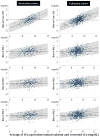Development and Validation of a Novel Laboratory-Specific Correction Equation for Total Serum Calcium and Its Association With Mortality Among Hemodialysis Patients
- PMID: 27714897
- PMCID: PMC5947953
- DOI: 10.1002/jbmr.3013
Development and Validation of a Novel Laboratory-Specific Correction Equation for Total Serum Calcium and Its Association With Mortality Among Hemodialysis Patients
Abstract
Conventional albumin-corrected calcium is inaccurate in predicting ionized calcium, and hidden hypercalcemia, characterized as high ionized calcium with normal total calcium, is associated with higher mortality in hemodialysis patients. By using a national cohort of hemodialysis patients in the Unites States, a novel laboratory-specific prediction equation composed of total calcium, albumin, and phosphorus was derived from 242 patients in the South Atlantic division (adjusted R2 = 0.80 versus 0.71 for the conventional equation) and then validated among 566 patients in the other divisions (adjusted R2 = 0.79 versus 0.68 for the conventional equation). Compared with the conventional equation, the novel equation showed a greater correlation with intact parathyroid hormone. Its relative performance against the conventional equation was consistent across subgroups based on medications related to calcium metabolism. The novel equation also had a higher sensitivity (57% versus 34%) and an equivalent specificity (99% versus 100%) against ionized hypercalcemia at a cut-off value of 10.2 mg/dL. Sensitivity and specificity at 9.4 mg/dL was 94% and 76% (versus 87% and 82% for the conventional equation), respectively. A survival analysis in 87,779 incident hemodialysis patients showed that among patients who were categorized as having a high-normal calcium status (ie, >9.4 to 10.2 mg/dL) by the conventional equation, there appeared a trend toward higher adjusted mortality risk across higher calcium status defined according to the novel equation. Meanwhile, the mortality risk was consistent across calcium strata defined according to the conventional equation within the categories defined by the novel equation. In conclusion, in comparison to the conventional equation, a novel laboratory-specific correction equation derived for correction of total calcium performs significantly better in ascertaining hidden hypercalcemia in hemodialysis patients, and aids in identifying patients at higher risk for mortality. © 2016 American Society for Bone and Mineral Research.
Keywords: DISORDERS OF CALCIUM/PHOSPHATE METABOLISM; EPIDEMIOLOGY; STATISTICAL METHODS.
© 2016 American Society for Bone and Mineral Research.
Figures




Similar articles
-
Association of Parameters of Mineral Bone Disorder with Mortality in Patients on Hemodialysis according to Level of Residual Kidney Function.Clin J Am Soc Nephrol. 2017 Jul 7;12(7):1118-1127. doi: 10.2215/CJN.11931116. Epub 2017 May 9. Clin J Am Soc Nephrol. 2017. PMID: 28487345 Free PMC article.
-
Hidden Hypercalcemia and Mortality Risk in Incident Hemodialysis Patients.J Clin Endocrinol Metab. 2016 Jun;101(6):2440-9. doi: 10.1210/jc.2016-1369. Epub 2016 Apr 5. J Clin Endocrinol Metab. 2016. PMID: 27045726 Free PMC article.
-
Abnormal mineral metabolism and mortality in hemodialysis patients with secondary hyperparathyroidism: evidence from marginal structural models used to adjust for time-dependent confounding.Am J Kidney Dis. 2014 Jun;63(6):979-87. doi: 10.1053/j.ajkd.2013.08.011. Epub 2013 Oct 8. Am J Kidney Dis. 2014. PMID: 24119541
-
Effectiveness of phosphate binders in adult patients with end stage renal disease receiving hemodialysis: a systematic review.JBI Database System Rev Implement Rep. 2019 Jan;17(1):49-73. doi: 10.11124/JBISRIR-2017-003740. JBI Database System Rev Implement Rep. 2019. PMID: 30204711
-
1alpha(OH)D3 One-alpha-hydroxy-cholecalciferol--an active vitamin D analog. Clinical studies on prophylaxis and treatment of secondary hyperparathyroidism in uremic patients on chronic dialysis.Dan Med Bull. 2008 Nov;55(4):186-210. Dan Med Bull. 2008. PMID: 19232159 Review.
Cited by
-
Validation of an equation for free calcium estimation: accuracy improves after adjustment for phosphate and CO2.Int Urol Nephrol. 2022 Oct;54(10):2625-2635. doi: 10.1007/s11255-022-03170-z. Epub 2022 Mar 16. Int Urol Nephrol. 2022. PMID: 35294676
-
Factors influencing the derivation and clinical application of blood calcium adjustment equations.Ann Clin Biochem. 2023 Jan;60(1):54-62. doi: 10.1177/00045632221131673. Epub 2022 Oct 14. Ann Clin Biochem. 2023. PMID: 36154292 Free PMC article.
-
Evaluation of bone densitometry by dual-energy x-ray absorptiometry as a fracture prediction tool in women with chronic kidney disease.Bone Rep. 2020 Jul 18;13:100298. doi: 10.1016/j.bonr.2020.100298. eCollection 2020 Dec. Bone Rep. 2020. PMID: 32743028 Free PMC article.
-
A New Predictive Equation for Estimating Serum Ionized Calcium Levels in Patients on Chronic Hemodialysis.Med Sci Monit. 2023 Oct 9;29:e941321. doi: 10.12659/MSM.941321. Med Sci Monit. 2023. PMID: 37807497 Free PMC article.
-
Disorders of Calcium Metabolism: Hypocalcemia and Hypercalcemia.Cureus. 2021 Jan 1;13(1):e12420. doi: 10.7759/cureus.12420. Cureus. 2021. PMID: 33542868 Free PMC article. Review.
References
-
- Block GA, Klassen PS, Lazarus JM, Ofsthun N, Lowrie EG, Chertow GM. Mineral metabolism, mortality, and morbidity in maintenance hemodialysis. J Am Soc Nephrol. 2004;15(8):2208–18. - PubMed
-
- Young EW, Albert JM, Satayathum S, et al. Predictors and consequences of altered mineral metabolism: the Dialysis Outcomes and Practice Patterns Study. Kidney Int. 2005;67(3):1179–87. - PubMed
-
- Kalantar-Zadeh K, Kuwae N, Regidor DL, et al. Survival predictability of time-varying indicators of bone disease in maintenance hemodialysis patients. Kidney Int. 2006;70(4):771–80. - PubMed
-
- Melamed ML, Eustace JA, Plantinga L, et al. Changes in serum calcium, phosphate, and PTH and the risk of death in incident dialysis patients: a longitudinal study. Kidney Int. 2006;70(2):351–7. - PubMed
Publication types
MeSH terms
Substances
Grants and funding
LinkOut - more resources
Full Text Sources
Other Literature Sources
Medical
Research Materials

